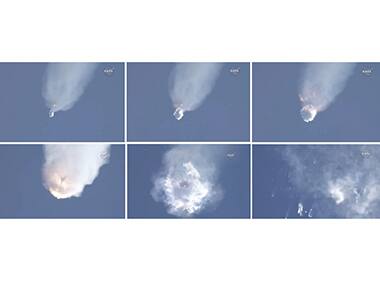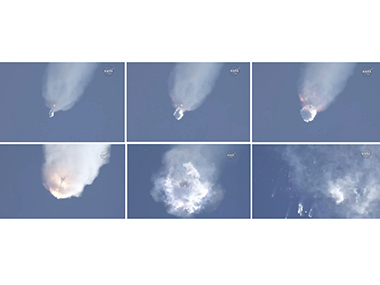Cape Canaveral: An unmanned SpaceX rocket exploded about two minutes after liftoff from Florida on Sunday, destroying a cargo ship bound for the International Space Station in the latest in a string of mishaps in supplying the orbiting outpost. The 208-foot-tall (63-meter) Falcon 9 rocket had flown 18 times previously since its 2010 debut, all successfully. Those missions included six station cargo runs for NASA under a 15-flight contract worth more than $2 billion. SpaceX, as the company is known, is owned and operated by technology entrepreneur Elon Musk. The cause of the accident was not immediately known. [caption id=“attachment_2316606” align=“alignleft” width=“380”]
 This June 28, 2015 sequence of images from NASA TV shows the SpaceX Falcon 9 rocket with the unmanned Dragon cargo capsule on board exploding shortly after launching from Cape Canaveral. Reuters[/caption] The station crew has about four months of food and supplies on board, so the accident would not pose an immediate problem. However, NASA’s second cargo line, run by Orbital ATK (OA.N), remains grounded following a launch accident in October. In April, a Russian Progress cargo ship also failed to reach the station. The station is expected to be returned to its full, six-member crew in July. But if food or water supplies dwindled to 45 days, some of the crew could return home via the Russian Soyuz capsules that are parked at the outpost. Sunday’s accident leaves the United States temporarily dependent on Russia and Japan to resupply the station. NASA’s second cargo transporter, run by Orbital ATK (OA.N), remains grounded following a launch accident in October. Russia hopes to return its troubled Soyuz rocket and Progress cargo ship to flight on Friday. Japan is slated to fly its HTV capsule to the station in August. Sunday’s problem started about two minutes and 19 seconds after liftoff when SpaceX lost contact with the Falcon, NASA launch commentator George Diller said. The accident occurred just before the rocket was to discard its first stage two minutes and 39 seconds after liftoff. Russia plans to launch a replacement Progress capsule on Friday. The Dragon spacecraft lost on Sunday carried 5,461 pounds (2,477 kg) of food, clothing, equipment and science experiments for the station, a $100 billion research laboratory that flies about 260 miles (420 km) above Earth. The gear included the first of two docking systems for space taxis under development by SpaceX and Boeing (BA.N) to park at the station. NASA hopes to turn over crew transportation to the U.S. companies before the end of 2017, breaking Russia’s monopoly. Including its station cargo runs for NASA, SpaceX has a backlog of nearly 50 missions, worth more than $7 billion, including dozens of commercial communications satellites. The company last month won U.S. Air Force certification to fly military and national security missions on the Falcon 9. SpaceX holds a second NASA contract, worth up to $2.6 billion, to upgrade its Dragon capsule to fly astronauts to the station. Boeing’s contract is worth up $4.2 billion. In addition to its launch pad at Cape Canaveral Air Force Station, SpaceX leases one of the mothballed space shuttle launch pads at the adjacent Kennedy Space Center and is building a new launch site in Texas. The company also has flown once from a launch pad at Vandenberg Air Force Base in California. Reuters
This June 28, 2015 sequence of images from NASA TV shows the SpaceX Falcon 9 rocket with the unmanned Dragon cargo capsule on board exploding shortly after launching from Cape Canaveral. Reuters[/caption] The station crew has about four months of food and supplies on board, so the accident would not pose an immediate problem. However, NASA’s second cargo line, run by Orbital ATK (OA.N), remains grounded following a launch accident in October. In April, a Russian Progress cargo ship also failed to reach the station. The station is expected to be returned to its full, six-member crew in July. But if food or water supplies dwindled to 45 days, some of the crew could return home via the Russian Soyuz capsules that are parked at the outpost. Sunday’s accident leaves the United States temporarily dependent on Russia and Japan to resupply the station. NASA’s second cargo transporter, run by Orbital ATK (OA.N), remains grounded following a launch accident in October. Russia hopes to return its troubled Soyuz rocket and Progress cargo ship to flight on Friday. Japan is slated to fly its HTV capsule to the station in August. Sunday’s problem started about two minutes and 19 seconds after liftoff when SpaceX lost contact with the Falcon, NASA launch commentator George Diller said. The accident occurred just before the rocket was to discard its first stage two minutes and 39 seconds after liftoff. Russia plans to launch a replacement Progress capsule on Friday. The Dragon spacecraft lost on Sunday carried 5,461 pounds (2,477 kg) of food, clothing, equipment and science experiments for the station, a $100 billion research laboratory that flies about 260 miles (420 km) above Earth. The gear included the first of two docking systems for space taxis under development by SpaceX and Boeing (BA.N) to park at the station. NASA hopes to turn over crew transportation to the U.S. companies before the end of 2017, breaking Russia’s monopoly. Including its station cargo runs for NASA, SpaceX has a backlog of nearly 50 missions, worth more than $7 billion, including dozens of commercial communications satellites. The company last month won U.S. Air Force certification to fly military and national security missions on the Falcon 9. SpaceX holds a second NASA contract, worth up to $2.6 billion, to upgrade its Dragon capsule to fly astronauts to the station. Boeing’s contract is worth up $4.2 billion. In addition to its launch pad at Cape Canaveral Air Force Station, SpaceX leases one of the mothballed space shuttle launch pads at the adjacent Kennedy Space Center and is building a new launch site in Texas. The company also has flown once from a launch pad at Vandenberg Air Force Base in California. Reuters
Nasa's International Space Station bound SpaceX rocket explodes after lift off from Florida
FP Archives
• June 29, 2015, 11:35:56 IST
An unmanned Space Exploration Technologies rocket exploded about two minutes after liftoff from Cape Canaveral Air Force Station in Florida on Sunday, destroying a cargo ship bound for the International Space Station, NASA said
Advertisement
)